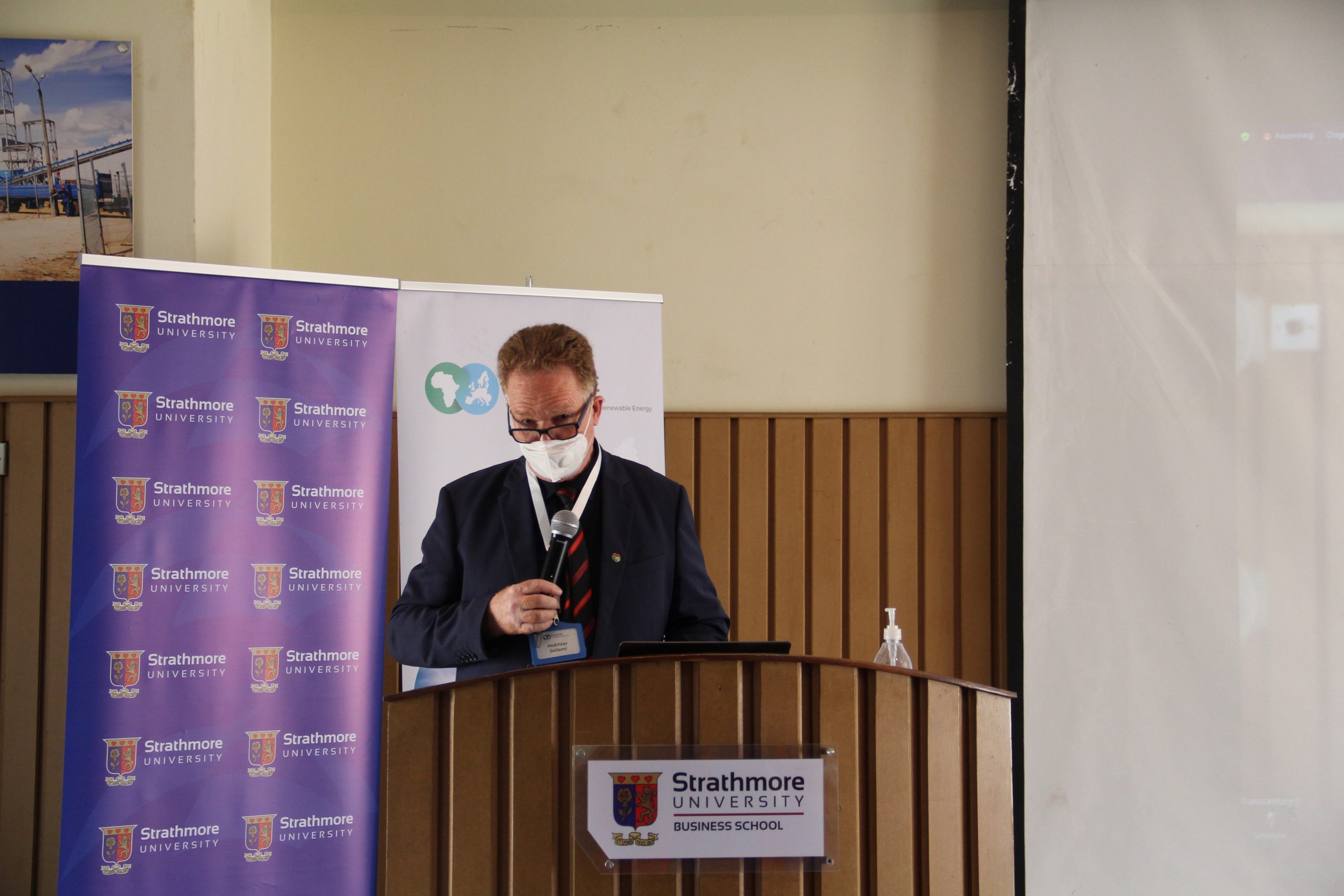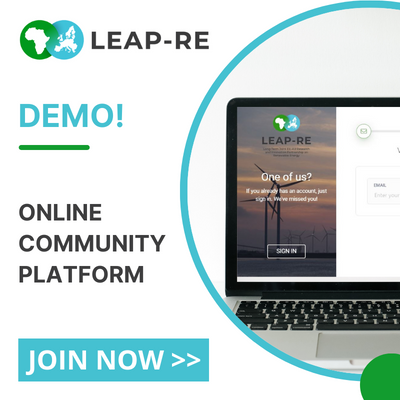In November 2021, the LEAP-RE General Assembly Meeting held the election of a chairperson and vice-chairperson for the programme. Mr Mokthar Sellami, from the Ministry of Higher Education and Scientific Research of Algeria (MESRS), was elected chairman of LEAP-RE, and Ms Isabella Nardini, from Fraunhofer IEG was elected as vice-chair. Their mandate mainly consists of monitoring the implementation of the project, arbitrating major changes in the project, and acting as ambassadors of LEAP-RE.
Question: What is your long-term vision of the partnership between Africa and Europe?
Mokthar Sellami (MS): Please allow me first to, once more, all the 83 LEAP-RE partners who placed their trust in me as the President of the General Assembly. I take this opportunity at the beginning of the New year to wish all of you a happy and fruitful year. Regarding the long-term vision of the partnership, I had an opportunity to participate in the building and launching of the HLPD since 2008, the different Senior Officials (SOM) meetings which took place in Brussels and Addis Abeba and the activities of the AU-EU High Level Policy Dialogue (HLPD) Bureau. This experience helped me to gain good understanding of this bilateral cooperation, its promises, ambitions and limitations. The last 5th AU-EU Summit of Heads of State and Government in Cote d’Ivoire confirmed the strong relationship between Africa and the European Union, and the COVID-19 demonstrates that we need each other more than ever before. Last year the European Commission confirmed and unveiled its roadmap titled ‘Towards a comprehensive strategy with Africa,’ to ensure a sustainable and resilient recovery to tackle together the challenges of the 21st century among them the Green Transition and Energy Access and the Digital Transformation. We are hoping that with time, this partnership will be strengthened to a deep and real cooperation in all research areas including emerging technologies with transfer of know-how, technical support, and investment in human capacities.
Isabella Nardini (IS): The LEAP-RE long-term vision needs to take into account lesson learned from the past bi-continental or multilateral actions. It needs to reflect the key objectives, priorities, and principles of governments (programme owners and funding agencies), research and academia, public and private sector.
The key objectives of cooperation in this area are to unlock the potential offered by research, technology & innovation, digital &green economy and to increase access to knowledge and skills better linked to employment.
Question: How can the LEAP-RE project establish itself as a long term bicontinental platform beyond 2025? What are some of the actions undertaken to achieve this goal?
MS: Regarding our common history, and each other’s expectations, the EU and the AU are convinced that there is a commitment for a long-term partnership that works for mutual benefit. But beyond the political commitment shared by many AU-EU leaders, there is lot of work to be done on the ground. Sustainability of cooperation will exist only if we create the right environment to allow students and researchers from both continents to interact, to work together, to build challenging projects for development. In LEAP-RE, we targeted a set of mechanisms to create and consolidate an AU-EU community of researchers and clusters of stakeholders in renewable energy. There a work package dedicated to the long-term cooperation, and we are designing some mechanisms to pro-actively involve researchers and to exploit their creative and collective intelligence, while making effective efforts to avoid any type of discrimination. Namely, these instruments are the matching principle, the teaming, twinning and share of infrastructures. To succeed in building the long-term partnership, we need the full commitment of all actors, and we believe that we have to first mobilize this potential, encourage them to get to know each other and to build trust. It is key to focus on the potential of knowledge transfer and to reinforce scientific and academic mobility to support the co-construction and/or co-reinforcement of training programs, and research projects in line with the LEAP-RE work packages.
Question: What is the role of the General Assembly under your stewardship in achieving the long-term aspiration of the LEAP-RE project?
MS: The role of the General Assembly is fundamental. It is of high importance to have common vision on the roadmap to adopt. Each member has a role, and it is essential to have the commitment of each individual involved in the different tasks. If partners don’t believe in what we are doing, the LEAP-RE project will just be a five-years programme with no impact or aspiration in building a successful log-term bi-continental partnership in renewable energy.
IN: The role is also to support the implementation of a long-term cooperation which includes operatively different actors covering complementary aspects (public, private, research, policy makers).
Question: What are some of the challenges of managing a consortium with 83 partners? How can the governance and coordination model of such a large programme be effective?
IN: It has been a great result to record the active, either in-presence and on-line participation by all Members to our first meeting in Nairobi. Many ideas, energy, overflowing with creativity and a strong ambition in work together clearly emerged.
MS: That being said, managing the consortium needs first the application of some basic rules. Among them is a flexible coordination, trust, shared vision, common agreement on procedures, respect between partners, transparency, mutual and continuous listening, good communication. If there is a lack of communication, it is not possible to have mutual understanding and mutual trust building. We have an online “FLEXX” portal that help us communicate internally and work effectively. We encourage partners to interact together and to know each other. We are thinking of establishing an internal rule guide to have at least a common understanding on how to interact together and on how to manage our actions, from respect of time for deliverables, to ethics rules.
Question: The renewable energy projects implemented under Pillar 1 and 2 are at the core of the LEAP-RE Programme. How do they promote co-creation and shared ownership of Intellectual Property and other knowledge produced from the projects?
MS: Intellectual property (IP) is a very important aspect to consider, elements governing this aspect are well defined in the H2020 rules. For the moment we are concentrating all our attention in launching and to have a good beginning of the Pillar 2 (8 projects) and Pillar 1 (13 projects tbc). The shared ownership of IP will be considered every step of the way in the projects conducted under these two pillars.
Question: LEAP-RE contributes to the Sustainable Development Goals (SDGs), and in particular SDG 7 which focuses on energy. How do the multi-annuals roadmaps that structure the LEAP-RE programme link the LEAP-RE project’s activities and outputs to SDG7’s targets?
MS: SDG 7 is connected to almost all other SDGs— including poverty eradication, gender equality, climate change, food security, health, education, sustainable cities and communities, clean water and sanitation, environment, jobs, innovation, transport, and displaced people.
The thematic priorities addressed in LEAP-RE, defined in the 6 Multi-Annual Roadmaps are closely connected to SDG7 and to ‘Agenda 2063: The Africa We Want’ developed during the preparation of LEAP-RE. The themes of the roadmaps are: Mapping RE joint research and innovation, End of life of RE components, Smart stand-alone systems, Smart grids, Productive uses of energy, domestic uses of energy. The LEAP-RE project was established through a collective effort and even if others may consider some of the Multi-Annual Roadmaps as less important in ensuring that African citizens have access to electricity, together, they form a collective and , ambitious approach to achieving these strategic objectives. More than 70% of the selected projects within LEAP-RE are investing in technology development and integration of renewable energy. We plan to have a special session during our next physical meeting in June 2022 to investigate how to reach the different objectives, based on relevant indicators. It is the priority of the General Assembly to have a clear vision on renewable energy systems deployment and to create value, this also including capacity building.
Question: What impact can LEAP-RE have in addressing the energy challenges in Africa in a sustainable and affordable manner?
MS: Renewable energy is critical to sustainable development and so is the role of LEAP-RE. Pillar 2 projects have started and are showing good progress, while Pillar 1 projects will launched soon as the selection of successful projects has just been concluded, these projects are quite promising looking the areas of renewable energy they are covering. It is still very early in the programme to assess its impact. We work in accordance with the outcomes and impact defined in the Multi-Annual Roadmaps, and indicators under constructions will guide our roadmap. We are aware that much groundwork is yet to be covered in capacity-building and technology transfer; this is our challenge.
IN: At this stage, it is worth noting that the LEAP-RE project has established the organisational and funding principles for the implementation of an African and European (AU-EU) Joint Programme by bringing together national funding agencies and other key EU-AU actors involved in renewable energy research. The Pillar2 research projects in different renewable energy fields started. Several on-site research actions in AU-countries have been carried out despite the difficult COVID pandemic.
Besides the expected scientific results, innovative energy technology, and other transversal achievements such as capacity building actions and transfer knowledge, one of the overall impacts will be to develop an integrated model in the energy research field resulting in positive effects on social and economic aspects. This will also include the alignment of existing multilateral frameworks in order to reduce the existing fragmentation
Thank you very much to Mr Mokthar Sellami & Ms Isabella Nardini for answering our questions.
Picture: Mr Mokthar Sellami at the LEAP-RE General Assembly Meeting in Nairobi, November 2021. © LEAP-RE




